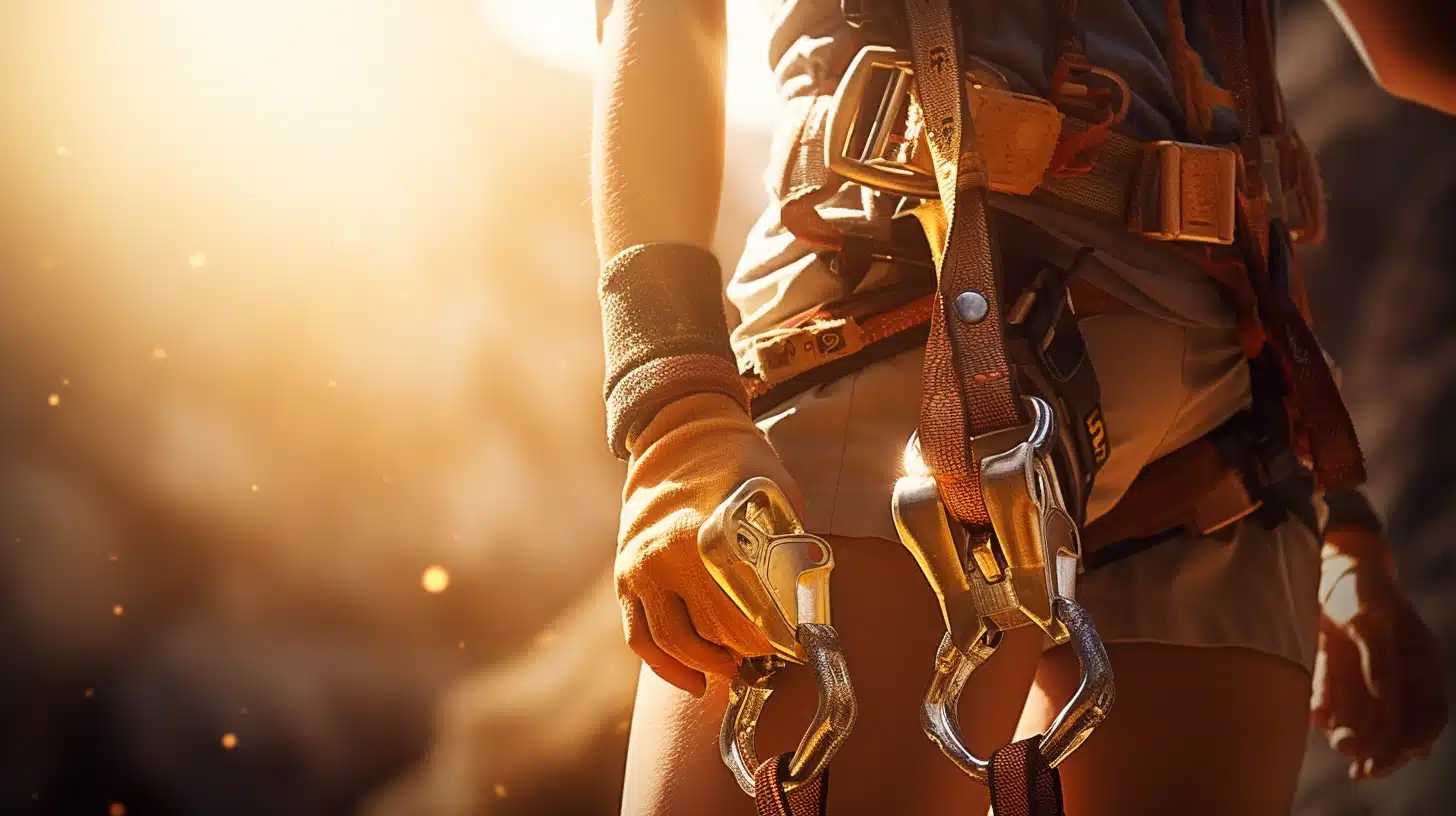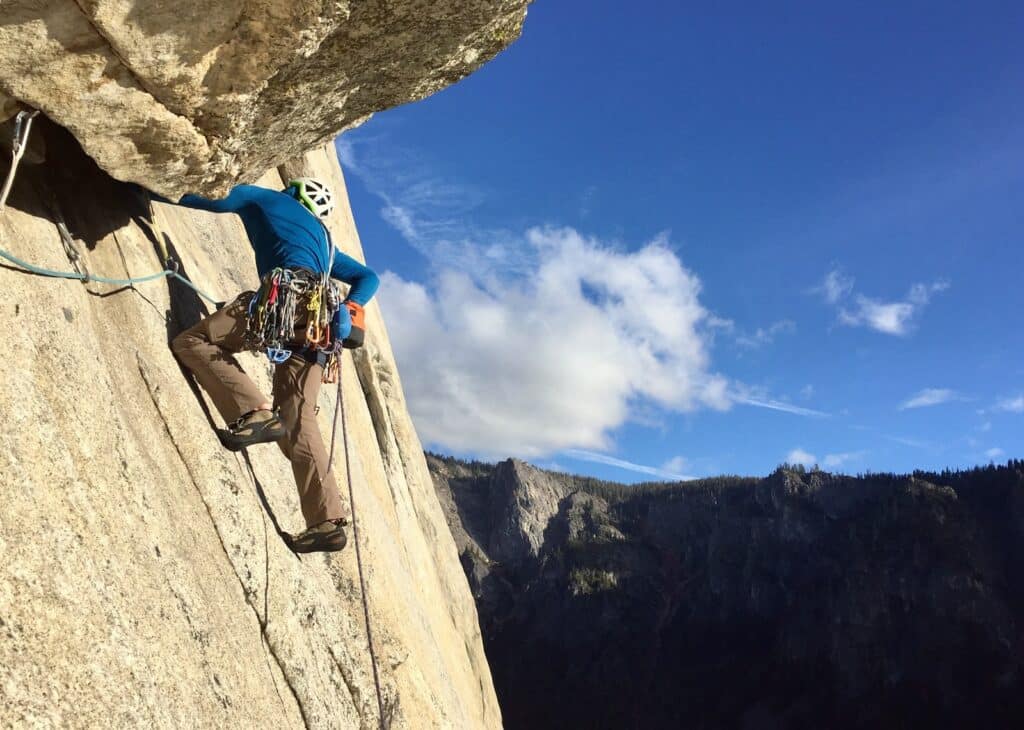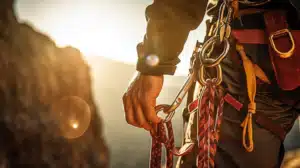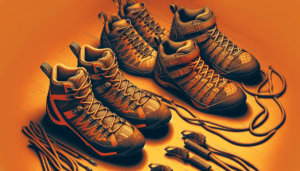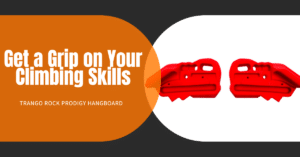Table of Contents
ToggleUnderstanding Trad Climbing Harnesses
In the fascinating world of traditional (trad) climbing, possessing the right gear is crucial. One such vital gear is the trad climbing harness. But what exactly is a trad climbing harness, and how does it differ from other types of climbing harnesses? Well, let me break it down for you.
What is a Trad Climbing Harness?
a trad climbing harness is specifically designed for traditional climbing, a style of climbing where the climber places their own protection in the rock as they ascend. This involves placing protection gear as you climb and removing it when you finish the climb.
In contrast to sport climbing, where protection is already fixed in the rock along the route, trad climbing requires climbers to carry and place their own trad climbing gear into the rock as they ascend. This gear is then removed by the climber or by the second climber following the lead climber.
Unique Features of Trad Harnesses
Trad climbing harnesses are designed to be versatile and durable, suitable for all types of traditional climbing, including big wall and multi-pitch routes. These harnesses typically have more gear loops and are more comfortable for hanging in for long periods of time compared to sport climbing harnesses. This is because trad climbers often need to carry a larger assortment of gear, like cams, nuts, hexes, and slings.
Moreover, traditional climbing harnesses are designed to be durable and supportive, with features like extra padding, reinforced tie-in points, and gear loops for carrying equipment.
So, whether you’re just starting out with trad climbing for beginners or you’re an experienced climber tackling multi-pitch routes, a good trad climbing harness is an essential piece of gear that can make your climbing experience safer and more enjoyable.
Choosing the Right Fit
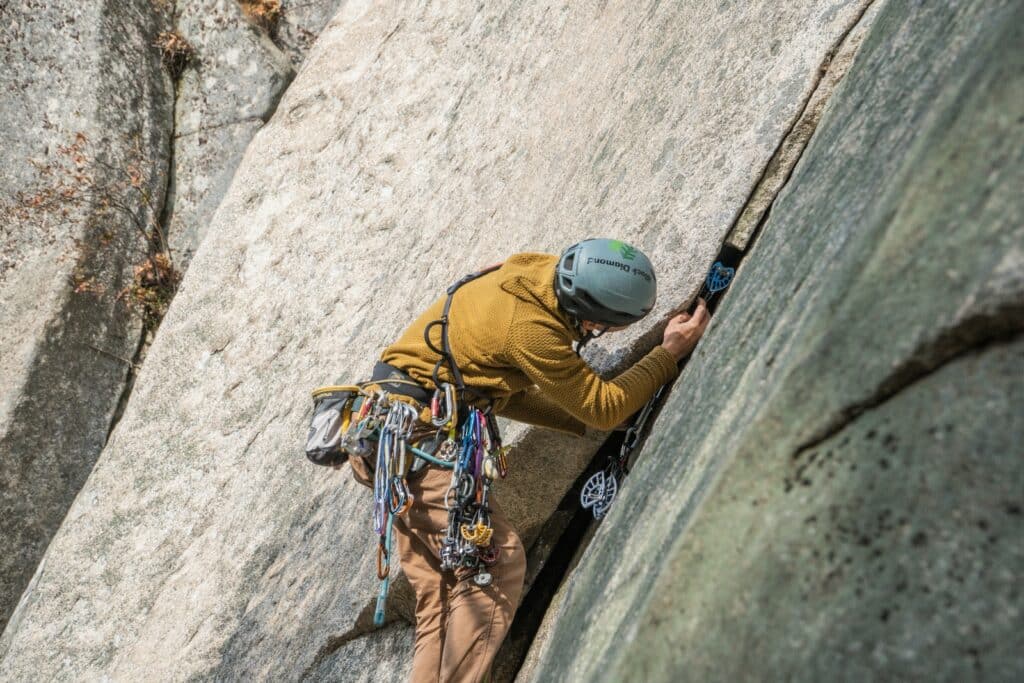
When it comes to trad climbing, the right harness can make a world of difference. It’s not just about safety; a well-fitting trad harness can enhance your climbing experience, comfort, and performance.
Importance of a Snug Fit
In the world of trad climbing, the fit of your harness is paramount. A well-fitted harness will provide you with the security and confidence needed for those challenging climbs. It should snugly fit around your waist and thighs, without being too tight or restrictive.
A good fit is essential for maintaining balance and control when you’re on the rock face. It also ensures that the harness will function effectively in case of a fall, distributing the impact force evenly across your body.
According to Backcountry, when considering the fit of a harness, it’s important to think about comfort, especially if you’re planning on tackling longer routes. Remember, a harness that feels uncomfortable on the ground is likely to feel even more uncomfortable when you’re hanging in it!
Adjustability of Trad Harnesses
Trad climbing harnesses stand out for their adjustability. This feature allows you to customize the fit of the harness, accommodating various clothing layers and body shapes.
Adjustable leg loops are a common feature in trad harnesses, as noted by Backcountry. They are often wider, providing more comfort for hanging belays and long periods of suspension. This adjustability ensures that no matter the size of your leggings or how many layers you are wearing, your harness will always fit perfectly.
Additionally, the waist belt on most trad harnesses is adjustable, allowing for a snug fit and versatility for different types of climbs. This means you can adjust the harness to your preference, ensuring comfort and security throughout your climb.
When choosing a trad climbing harness, it’s vital to consider factors such as fit, comfort, gear loops, and weight to find one that suits your climbing style and preferences.
Remember, climbing is a journey, not a destination. Choosing the right harness is key to enjoying this journey. Check out our other articles on trad climbing gear for more information on the equipment you’ll need for your climbing adventures.
Essential Components of Trad Harnesses
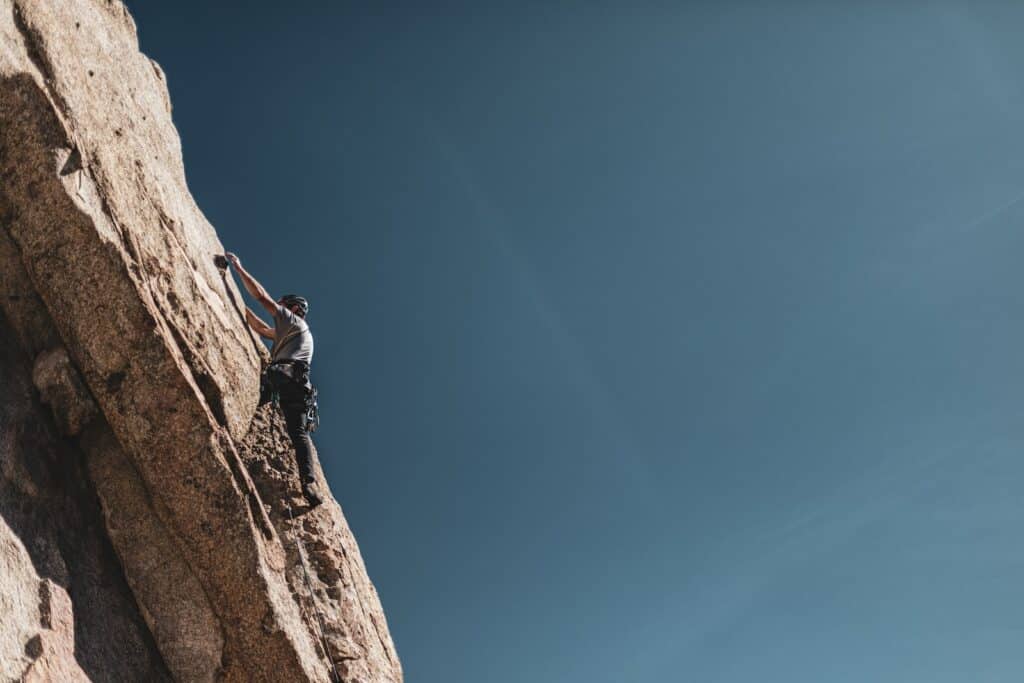
When it comes to trad climbing, the harness you choose plays a crucial role in both your safety and comfort. Trad climbing harnesses have specific features that set them apart from other types of climbing harnesses. Let’s take a closer look at some of these key components.
Waist Belt and Leg Loops
The waist belt and leg loops of a trad harness are typically wider and more padded compared to those of a sport climbing harness. This extra width and padding help distribute the weight of your body and gear more evenly, reducing pressure points and discomfort during extended periods of hanging or belaying.
In addition to providing more comfort, trad harnesses often have adjustable leg loops. These adjustable loops are designed to accommodate different clothing layers and sizes, providing a more customized fit. This is especially helpful in climates where weather conditions can change rapidly, requiring different layers of clothing.
Gear Loops and Attachment Points
Trad climbing harnesses are specifically designed to carry and organize the additional gear required for traditional climbing. They often feature multiple gear loops and haul loops for attaching carabiners, quickdraws, and other essential climbing equipment.
These harnesses typically have a higher gear loop count, usually between four and six gear loops, to accommodate a large number of cams, nuts, and other protection devices. This allows for easy access to your gear during a climb, making it quicker and more efficient to place and remove protection.
Understanding these essential components of trad harnesses can help you choose the right one for your needs. Whether you’re a beginner just getting started with trad climbing or an expert looking to upgrade your current harness, it’s important to choose a harness that offers both comfort and functionality. Check out our trad climbing gear guide for more information on choosing the right equipment for your climbing adventures.
Examining Popular Trad Harness Models
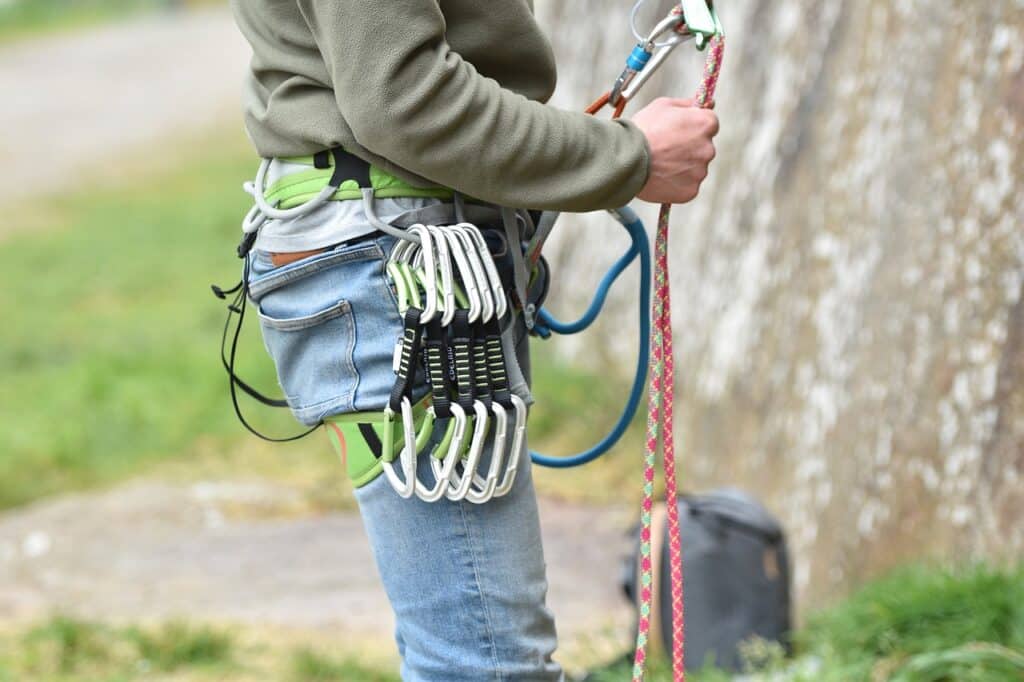
When it comes to trad climbing, the right gear is a game-changer. One of the essential pieces of gear in your trad climbing arsenal should be a comfortable and reliable harness. To help you find the perfect fit, let’s examine some of the most popular trad climbing harness models on the market.
Petzl Sitta
First up is the Petzl Sitta, one of the lightest trad climbing harnesses available. It weighs in at just 9.5 ounces, so you’ll hardly feel it as you’re scaling those walls. Don’t let the lightweight nature of this harness fool you, though. The Petzl Sitta is both robust and comfortable, making it an excellent choice for those long, challenging climbs.
While this harness might be a bit more expensive than others on the market, I believe that the comfort and lightweight design make it a worthy investment for any serious trad climber.
Black Diamond Chaos
Next up is the Black Diamond Chaos. Known for its comfort, this harness features wide and padded leg loops and a contoured waistbelt. The Black Diamond Chaos is designed to provide maximum comfort during those long climbs.
If you’re someone who values comfort over everything else, the Black Diamond Chaos is the harness for you. The padded leg loops and waist belt provide a level of comfort that’s hard to beat.
Petzl Hirundos
The Petzl Hirundos is another solid option for trad climbers. This harness features a unique “Fuseframe” construction that evenly distributes pressure for maximum comfort and support.
The Petzl Hirundos is a fantastic choice if you value both comfort and flexibility in your harness. The “Fuseframe” construction provides you with the support you need without compromising on comfort.
In conclusion, the best trad climbing harness for you will depend on your personal preferences and climbing needs. Whether you value lightness, comfort, or a balance of both, there’s a harness out there that’s perfect for you. For more information on trad climbing gear, check out our article on trad climbing gear.
Safety Standards for Trad Harnesses
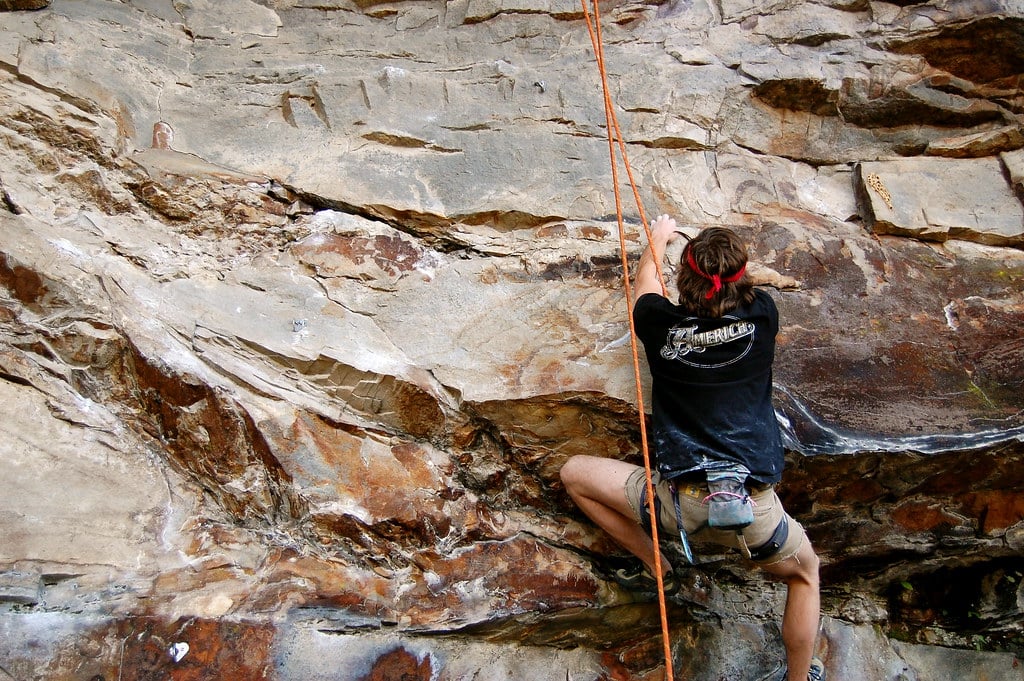
When it comes to trad climbing, safety is paramount. This is where the harness comes in; it’s not just a piece of gear but a lifeline that keeps you anchored and secure. Therefore, ensuring that your trad climbing harness meets the required safety standards is critical.
UIAA Safety Standards
The International Climbing and Mountaineering Federation, more commonly known as the UIAA, established safety standards for trad climbing harnesses back in 2013. These standards set specific requirements related to materials, construction, strength, and design that trad climbing harnesses must meet.
But how do you ensure that the harness you’re considering meets these safety standards? Look for the UIAA Safety Label. This certification system guarantees that the harness aligns with the UIAA’s safety standards. Each UIAA Safety Label includes an identification number, allowing climbers to verify the authenticity of the product and confirm that it meets the required safety standards.
Importance of Harness Certifications
When purchasing trad climbing harnesses, it’s essential to check for the UIAA Safety Label. This label is your assurance that the harness you’re buying has passed rigorous safety testing and meets the necessary standards for climbing.
Ignoring this could mean compromising on safety, and that’s a risk I strongly advise against taking. Always remember, your safety is paramount, and it starts with choosing the right gear. So, whether you’re a beginner looking to get started with trad climbing or an experienced climber looking to upgrade your gear, always prioritize safety.
In the world of trad climbing, your gear is more than just equipment; it’s your safety line. So, choose wisely, climb safely, and never stop exploring! For more information on trad climbing safety, check out our article on trad climbing safety.
Caring for Your Trad Harness
Trad climbing harnesses, like all climbing equipment, require careful inspection and maintenance to ensure safety and longevity. In this section, we’ll delve into the steps you should take to properly care for your trad harness.
Regular Inspection and Maintenance
I can’t stress enough the importance of regularly inspecting your trad climbing harness for any signs of wear, such as frayed stitching, worn webbing, or damaged gear loops. It’s essential to check the belay loop, tie-in points, and gear loops for any signs of wear or damage. If you notice any issues, it’s time to retire the harness.
Cleaning and storing your harness properly is also key to maintaining its integrity. Always follow the manufacturer’s guidelines for care. Avoid exposing your harness to harsh chemicals, excessive heat, or prolonged sunlight, as these could degrade the materials and compromise the integrity of the harness.
When to Replace Your Harness
Knowing when to replace your trad climbing harness is crucial for your safety. If your harness has been subjected to a significant fall or impact, it’s recommended to retire the harness and replace it, even if there are no visible signs of damage. The force of a fall can weaken the materials and compromise the structural integrity of the harness.
If your harness has been exposed to chemicals, such as battery acid or corrosive substances, it’s time to replace it. These substances can weaken the materials and compromise the safety of the harness.
Similarly, exposure to extreme temperatures, such as freezing cold or intense heat, can weaken the materials and compromise the safety of the harness. If your harness has been in these conditions, it’s time for a new one.
Lastly, you should retire your harness if it has been used extensively over a long period of time. The materials can degrade and weaken with age, so regular assessments of the condition of your harness are important.
Caring for your trad harness involves regular inspection, proper cleaning and storage, and knowing when it’s time to replace it. Doing so will ensure that you can trust your gear when you’re out there on your trad climbing routes. So, keep climbing and stay safe!

